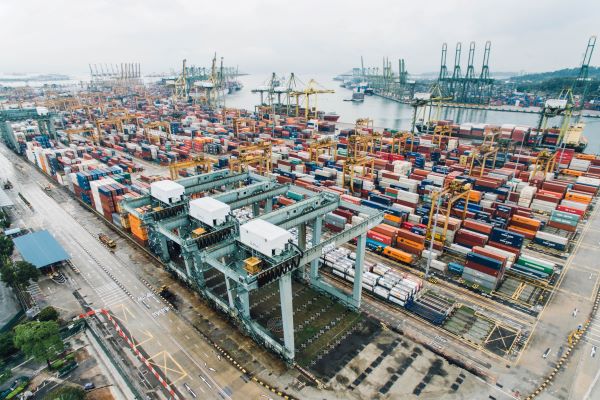The shipping industry in Africa is finding ways to decrease its carbon footprint. Africa can become a leader in green shipping in the agricultural sector by reflecting on its history and following precedents set by the growing environmental movement.
1. Ship a Variety of Products
Sustainability equates to stability, and relying on a single commodity could break a business. Choosing ethically sourced agricultural products — such as fair trade, local and sustainably farmed — is important, but it’s also essential to vary a farm’s crop output as much as possible.
This trend has appeared in Africa’s agricultural history. Governments manipulated food prices to satisfy urban desires for cheap produce, which limited how much farms could diversify and commercialize. Crops that didn’t yield profits didn’t get planted.
2. Create a Sustainability Initiative
The agricultural shipping industry cannot make sustainable strides if it doesn’t create a course of action to achieve greener goals. Incorporating sustainability into a business model is a long-term, high-intensity engagement, especially if there aren’t any current eco-friendly initiatives. Making a list of environmentally focused values to abide by will help employees understand their position with more purpose and a global perspective.
3. Decrease Waste and Land Damage With Security
There are multiple factors to consider when storing and securing products. Agricultural products shipped across continents must stay protected. Having sustainable agriculture means not losing any of the items intended to be shipped. With several points of unrest causing disruptions in African agriculture, shipping companies must take heed.
Businesses have been looted or set on fire, and crops and livestock are affected. Farmers must find or create insurance policies for their exports so companies stay afloat sustainably.
4. Follow Green Standards and Get Certified
Standards and certifications are Africa’s best and most authoritative ways to push for a greener agricultural shipping sector. These often require businesses to create mission statements and values to progress their green agenda.
Here are some of the guidelines and certifications in the shipping industry:
- Energy Efficiency Index
- ISO 14001
- Green Marine
- Environmental Ship Index
- Clean Cargo
- Green Award
It’s not necessary to receive all of them, but it’s great to consider options to see how to get the official stamp of eco-friendly shipping.
5. Do Not Resort to Less Environmentally Friendly Options
Exports from Africa are rising as it becomes a global contender in agricultural shipping. The continent has done this by diversifying the countries responsible for producing major exports of cocoa, coffee and cotton, including lower-income nations like Kenya and Ghana. This can help make the shipping industry greener by decreasing transportation costs while empowering struggling regions. This is not a time to cut corners for less eco-friendly options.
The reality is access to food is limited and not distributed evenly worldwide, so it may be enticing to use less clean options to keep up with demand. Sustainability progresses through continued persistence. If agriculture and shipping can be green when business booms, they can maintain value when obstacles arise.
6. Ship to Greener Locations, Like Ports
Boats transport 90% of global trade overseas that arrive in ports. Africa relies on its coastal environments, and creating new ports and upgrading current ones to be more eco-friendly is the obvious choice for greener shipping for agricultural products. They are naturally less obtrusive to the environment if appropriately structured.
One of the ways this can look is by creating multipurpose ports that are not just for shipping. Existing ports can also be changed to interact more efficiently with the aquatic environment, called BioEnhancement. Restructuring port walls and removing sediment could improve biodiversity.
Ports are a hot topic regarding the future of sustainable shipping worldwide. The United Nations Sustainable Development Goals have even placed a high priority on implementing them since they influence multiple initiatives simultaneously.
7. Create a Smarter Agricultural Foundation
While people build better shipping infrastructure, the agricultural foundation must be sound, sturdy and regenerative. The changes made to the environment may be for long-term environmental betterment, but implementing these changes must still be as minimally damaging as possible.
Africa can continue to do this by executing climate-smart agriculture, which produces these outcomes:
- More productivity. Nutrition and income security will rise alongside greater food production.
- Greater resilience. Farms prioritize reducing vulnerability to environmental hazards like pests and climate risks for smoother adaptation to other influences.
- Reduced emissions. Methods include avoiding deforestation and using regenerative farming to absorb carbon if possible.
8. Choose More Consciously Fueled Transportation
Africa is attempting to use hydrogen-derived fuels to obtain low to zero carbon emissions in marine transportation like tankers and bulk carriers. Biofuels and batteries are created with renewable energy sources. Perfecting these will be a significant step in creating greener transportation, as South Africa is still heavily reliant on coal. Once engineered, the same energy methods could be applied to related industries to shipping and agriculture, like manufacturing.
9. Increase Productivity to Waste Fewer Resources
Africa is made up of plenty of small plots and self-sufficient farms. Because of this, technological advancement has not increased at the same rate as in other parts of the world. Though adding technology such as machinery, sprinklers and fertilizers may appear to use resources, the increase in productivity will assist in keeping the land as healthy as possible while simultaneously increasing output.
10. Collaborate, Share and Research
The agricultural shipping sector in Africa has become greener alongside the rest of the world’s desire to be more sustainable. Initiatives like Europe’s Green New Deal are examples of how efforts outside of a continent can inspire and progress from all directions.
The shipping and agricultural industries are changing every day. Continued research will yield success in crafting an environmentally ideal model. This curiosity will transform into publicity, leading to collaborations and more significant impacts worldwide.
Greener Agricultural Shipping in Africa
Experts circulate new ideas daily about how to make humanity more attentive to the planet. Agriculture relies on the Earth’s health, so greener shifts need to occur to find success and continue feeding the masses.

Jane is an agriculture and environmental journalist and the founder and editor-in-chief of Environment.co, where she covers sustainability and eco-friendly living.









